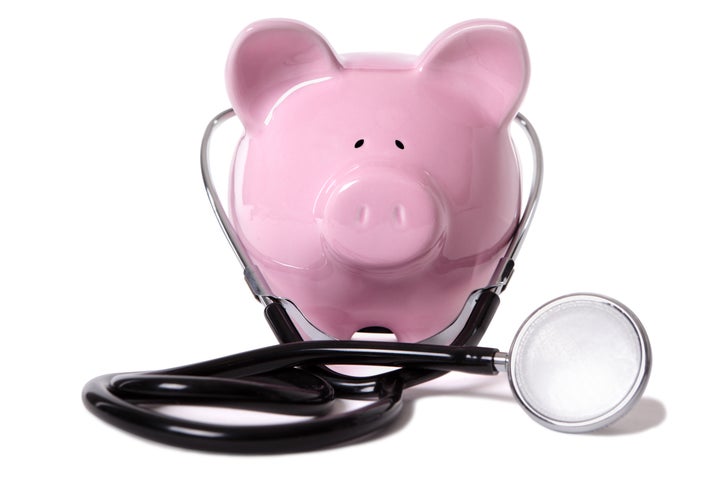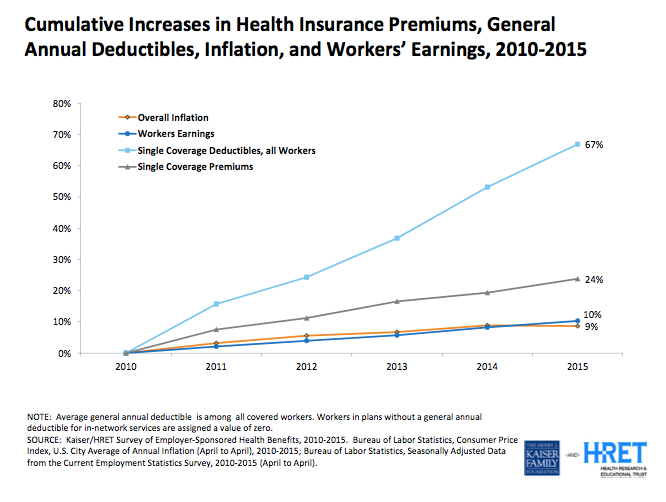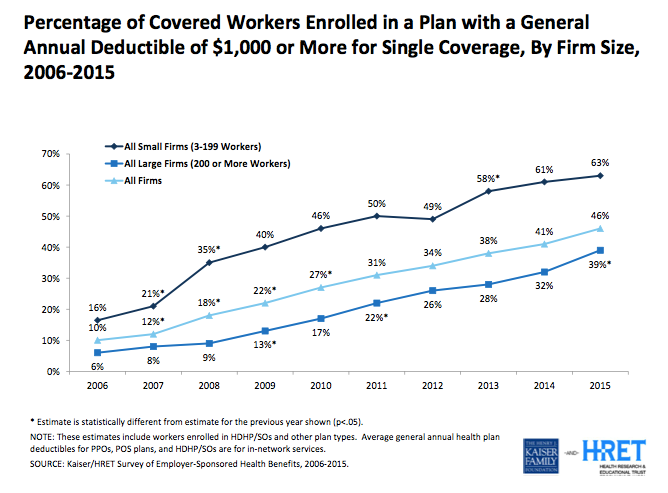
Ask a typical economist about what’s happening to health insurance, and you’ll hear about a historic slowdown in inflation. For roughly a decade, the economist will explain, the year-to-year increases in premiums have been surprisingly low.
But ask a typical consumer the same question, and you’re likely to hear a different story. It will be all about how expensive health care is getting -- particularly the out-of-pocket costs, which are getting so high that many people have to think twice before going to the doctor, filling a prescription or getting a procedure.
Who’s right? Both, actually, and a new report shows why.
The report, released Tuesday, is the annual survey of employer health insurance by the Henry J. Kaiser Family Foundation and Health Research and Educational Trust. The survey is one of the best indicators available for trends in U.S. health insurance costs.
This year’s report actually looks a lot like last year’s -- and, in one sense, that’s good news. According to the data, the average premium for a single person's coverage is $6,251, with workers directly contributing $1,071 and the rest coming invisibly out of their paychecks. The average family premium is $17,545, of which workers directly pay an average of $4,955.
That’s obviously a lot of money, particularly by international standards. But this year’s premiums are just 4 percent higher than last year’s. And that’s consistent with the trend going back a decade. Since 2005, premiums have risen by an average of 5 percent. In the six years prior to that, the Kaiser/HRET report notes, they were rising by 11 percent. This is the news economists love to celebrate.
But consumers may feel differently. Most people don't consider historical counterfactuals. When they get their paychecks, they don’t stop and calculate how much higher their premiums would be -- and how much lower their take-home pay would be -- if health care costs were rising as quickly as they were at the end of the 1990s.

In addition, wages have been rising even more slowly than premiums for the last decade. As a result, even these modest increases in health insurance premiums feel like they are imposing an added burden.
The real pain most workers feel these days, though, isn’t the premiums. It’s the out-of-pocket costs -- the co-payments, co-insurance and deductibles they must hand over at the pharmacy or doctor’s office or after a hospital stay. Unlike premiums, these out-of-pocket costs are rising quickly. Since 2010, according to the Kaiser/HRET study, the cumulative increase in deductibles has been more than twice the cumulative increase in premiums.
Higher cost-sharing can have upsides. By making individual consumers more sensitive to the price of individual services and treatments, these out-of-pocket expenses can cause people to think twice about medications or procedures that might not be worthwhile. And in those cases when consumers can’t avoid getting some kind of medical care, higher cost-sharing might prod them to shop around for providers that charge less money.
Economists and business leaders like to call this giving people “skin in the game.” A large body of research has shown that, on the whole, it reduces the consumption of health care services, which reduces total health care spending, eventually leading to lower premiums.

But consumers can't always distinguish worthwhile care from the wasteful kind. And when employers shift costs onto individual workers, it ends up pushing the burden of medical spending onto those with the worst conditions. In a given firm, the majority of employees who are in relatively good health may end up saving money as premiums rise more slowly. Meanwhile, the minority with serious problems will find themselves owing much more through all the co-payments and deductibles.
The burden can be particularly crippling for workers with lower incomes, since they may not have the disposable income or the savings to cover chemotherapy drugs or weeks of rehabilitation after an injury.
“The good news is that we’re in the tenth year of moderate premium increases, but it’s not at all a good thing for consumers that cost-sharing and deductibles keep going up and up this way,” Drew Altman, president of the Kaiser Family Foundation, told The Huffington Post. “And what’s really significant here is that these costs are going up quickly at a time when wages are flat. If wages were rising more quickly, it wouldn’t be so painful for consumers.”
Addressing the rise in out-of-pocket spending may become a focus of health care policy in the coming years, starting with the presidential campaign. The Affordable Care Act already imposed limits on out-of-pocket spending. On Tuesday, Democratic presidential candidate Hillary Clinton proposed placing separate, tighter limits on out-of-pocket spending for certain kinds of prescription drugs. But imposing measures like these is tricky business, given the relationship between out-of-pocket spending and premiums. Push one down and, absent other actions to control the cost of health care, the other will go up.
Constructing the political coalition necessary to pass measures like Clinton’s could be difficult as well. Conservatives have attacked higher cost-sharing recently, saying it’s a consequence of the Affordable Care Act and the pressure it has put on employers. However, they have traditionally been enthusiastic about cost-sharing, and their preferred health care reforms usually call for more of it, not less.
